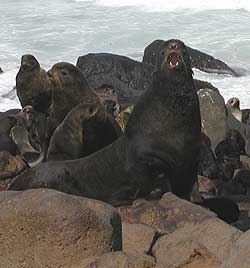Northern Fur Seal
Common Name: Northern Fur Seal
Scientific Name: Callorhinus ursinus

Description
The Northern Fur Seal ranges from the Arctic Ocean to southern California in the winter, and Pribilof Islands in the central Bearing Sea and San Miguel Islands off California in the summer. They are not found in the Atlantic Ocean. Of all the Northern Fur Seals 75% breed and pup on the Pribilof Islands. Males arrive in late spring and stake out and defend a territory that a female will later seek out to give birth and nurse her pups. Females arrive about one month after the males and begin to form groups within the male territories that have been defined. They are one of the most oceangoing of the aquatic carnivores and only returns to land only during the breeding season.
Size
Pups weigh up to 5.4 kg at birth; adult males average 2.1 m in length and can weigh up to 275 kg. Adult females are much smaller; they weigh 30 to 50kg.
Breeding
During the summer breeding season, most of the worldwide population is found on the Pribilof Islands in the southern Bering Sea, with the remaining animals on rookeries in Russia, on Bogoslof Island in the southern Bering Sea, and on San Miguel Island off southern California. At the rookeries, adult males set up territories in May, females arrive in June and give birth to one pup a few days later. Most pups are weaned at about 4 months in November.
After the breeding season, adult males from the Pribilof Islands migrate to the Gulf of Alaska , while adult females and juveniles migrate through the Aleutian Islands into the North Pacific Ocean, often as far south as the Oregon and California offshore waters. Many pups may remain at sea nearly 2 years before returning to their rookery of birth.
Life Hiistory
Beginning in May, the seals start returning to the breeding islands. Older males, or bulls, arrive first to vie for prime breeding territories prior to the arrival of females. Breeding males are typically 10 or more years old, maintain females within their territories, and accomplish the majority of breeding. Idle males are adult males within the size and age range of breeding males but do not maintain females and may or may not be territorial. Males holding territory remain on territory for an average of 50 days and fast during that time, losing 20%-25% of their mass (Johnson 1968). There is some turnover of breeding males later in the season when some idle males become breeding males. Sub-adult males, or SAMs, usually congregate on shore in areas called "haulouts" during the summer breeding season. There is a typical structure to fur seal rookeries, the core group of breeding males with females, idle males without females on the fringe of the core area, and idle males and sub-adult males on haulouts outside the rookery areas.
Females typically start returning to the breeding islands in June and give birth to a single pup within a few days after arrival on land. Females generally have their first pup at 5-6 years of age and copulate 5-14 days after giving birth. Females suckle their pups for 2-4 days and then go to sea for 4-14 day feeding trips. Pups are nursed until weaning and migration in November and may not return to the islands until their second year of life. The pregnancy rate for females is approximately 60% for females age 3 and greater, and 68% for females age 4 and greater (York 1987). Nearly 90% of females in their reproductive prime, 8-13 years old, are pregnant every year with the pregnancy rate gradually decreasing after 13 years of age. Survival rates for female and male fur seals vary by age (Lander 1981).
 Deep Sea Crabs
Deep Sea Crabs